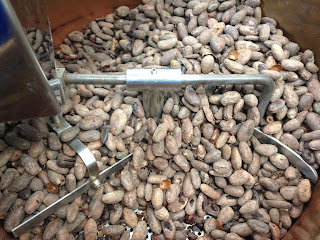Our first stop was for a traditional Dominican breakfast - eggs scrambled with tomatoes, fried cheese and mangu, a classic Dominican dish made from mashed green plantains. Everything was delicious.
Our next stop was at the Mirabel Sisters' Museum in Salcedo where we were not allowed to take pictures. It marks a turning point in Dominican history. For over thirty decades, the country was run by dictator Rafael Trujillo, aka El Jefe or The Goat. The Mirabel sisters were part of an undercover group opposed to his regime. They and their husbands were incarcerated several times for their activities. The women and their driver were clubbed to death by Trujillo's henchmen in November of 1960. In 1999, the UN General Assembly honoured the sisters' sacrifice by making November 25 the International Day for the Elimination of Violence Against Women.
This was a lovely gesture, but in no way affects the reality of Dominican women. The country's rates of violence against women and femicide are amongst the highest in the world. The Ministry of Women’s Affairs has the second smallest budget in public administration and the Women’s Advocate Office does not even have a budget at all.
But I digress. After a very well moderated tour, during which the students were on their best behaviour, we got back on the bus for our final stop, an organic cocoa plantation and chocolate factory owned by the father of one of our students.
 |
| That's me in the middle. I accidentally wore clothes almost identical to the school uniform. |
Blue trumpet vine at the entrance. Isn't it gorgeous?
Cocoa beans inside the pod, coated in slimy stuff just like a newborn.
Cocoa sprouts.
Our lovely guide demonstrating how cocoa plants are grafted. Only branches from the best "mothers" are used. Yield is about 4 times greater than on trees sprouted from seeds. Those are used just for their trunks.
A mature worker holds a mature cocoa pod.
The pods grow directly off the tree trunks.
I cannot conceive of how hot it must have been inside this cocoa bean costume. I was soaking with sweat just from walking around in light clothing.
No one wants to find a hair in their chocolate bar.
Beans are fermented for five days, then dried and roasted before being ground.
Students are working furiously at a chemistry worksheet. Way to take the fun out of a chocolate factory!
Each student chose a mold and this lovely lady filled it with freshly made chocolate. They were cooled, unmolded and delivered to our bus just in time for our departure after a really good lunch.
We left about an hour and a half behind schedule, thereby hitting rush hour in Santo Domingo. By the time we got back to school at 5:20 pm, I was suffering badly from overexposure to noise generally and teenage noise in particular. It was a great day from which it took me three to recover!















Very interesting to see the various components and processes of chocolate making. Was the aroma strong?
ReplyDeleteNot really. They weren't roasting when we were there, and I think that is where the most molecules are released. To be honest, we've all had better chocolate.
ReplyDelete